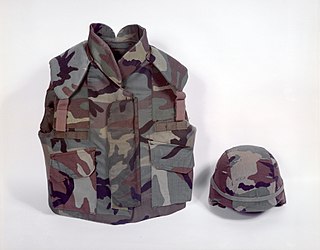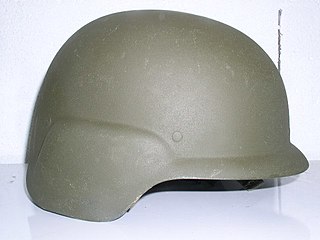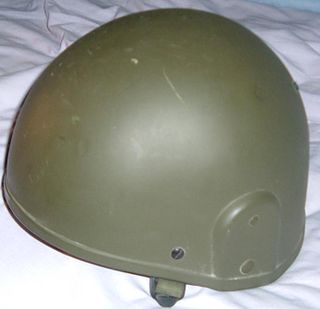
Fedayeen Saddam was a paramilitary organization loyal to the Ba'athist Iraqi government of Saddam Hussein. The name was chosen to mean "Saddam's Men of Sacrifice". At its height, the group had 30,000–40,000 members.

The Victory Arch, officially known as the Swords of Qādisīyah، and popularly called the Hands of Victory or the Crossed Swords, are a pair of triumphal arches in central Baghdad, Iraq. Each arch consists of a pair of outstretched hands holding crossed swords. The two arches mark the two entrances to Grand Festivities Square and the parade ground constructed to commemorate the Iran–Iraq War, started and led by then Iraqi President Saddam Hussein. The arches were opened to the public on 8 August 1989. It is one of Baghdad's visitor attractions and near to The Monument to the Unknown Soldier.

The T-90 is a third-generation Russian main battle tank. It uses a 125 mm 2A46 smoothbore main gun, the 1A45T fire-control system, an upgraded engine, and gunner's thermal sight. Standard protective measures include a blend of steel and composite armour, smoke grenade dischargers, Kontakt-5 explosive-reactive armour and the Shtora infrared ATGM jamming system

The Desert Battle Dress Uniform (DBDU) is a U.S. arid-environment camouflage battle uniform that was used by the United States Armed Forces from the early 1980s to the early to mid 1990s, most notably during the Persian Gulf War. Although the U.S. military has long since abandoned the pattern, it is still in widespread use by militaries across the world as of the early 2020s.

The Stahlhelm is a German military steel combat helmet intended to provide protection against shrapnel and fragments of grenades. The term Stahlhelm refers both to a generic steel helmet and more specifically to the distinctive German military design.

The 80th Training Command is a formation of the United States Army Reserve.

Personnel Armor System for Ground Troops is a combat helmet and ballistic vest that was used by the United States military from the early 1980s until the mid-2000s, when the helmet and vest were succeeded by the Lightweight Helmet (LWH), Modular Integrated Communications Helmet (MICH), and Interceptor Body Armor (IBA) respectively.

The M1 helmet is a combat helmet that was used by the U.S. military from World War II until 1985, when it was succeeded by the PASGT helmet. The M1 helmet has become an icon of the US military, with its design inspiring other militaries around the world.

The FV101 Scorpion is a British armoured reconnaissance vehicle, and also a light tank. It was the lead vehicle and the fire support type in the Combat Vehicle Reconnaissance (Tracked), CVR(T), family of seven armoured vehicles. Manufactured by Alvis, it was introduced into service with the British Army in 1973 and was withdrawn in 1994. More than 3,000 were produced and used as a reconnaissance vehicle or a light tank. It holds the Guinness world record for the fastest production tank; recorded doing 82.23 km/h (51.10 mph) at the QinetiQ vehicle test track, Chertsey, Surrey, on 26 January 2002.

The Modular Integrated Communications Helmet (MICH) is a U.S. combat helmet and one of several used by the U.S. military. It was developed by the United States Army Soldier Systems Center to be the next generation of protective combat helmets for use by the U.S. Army.

The SPECTRA helmet or CGF Gallet Combat Helmet is the PASGT-style ballistic helmet in use with the French military, and the armies of several other countries. Built by CGF Gallet, it weighs 1.4 kg (3.1 lb), is available in three sizes, and is made from ultra-high-molecular-weight polyethylene Spectra fibers, produced under license from Honeywell.

The Advanced Combat Helmet (ACH) is the United States Army's current combat helmet, used since the early 2000s. It was developed by the United States Army Soldier Systems Center, the U.S. Army Special Operations Command, and the U.S. Army Research Laboratory to be the next generation of protective combat helmets for use by the American ground forces. The ACH is derived from the Modular Integrated Communications Helmet. The ACH is currently in the process of being phased out and replaced by the Enhanced Combat Helmet (ECH), an improvement upon the ACH derived from its design; however, both the ACH and the newer ECH are being replaced by the Integrated Head Protection System.

The M1117 Guardian, also denoted Armored Security Vehicle (ASV), is an internal security vehicle based on the V-100 and V-150 Commando series of armored cars. It was developed in the late 1990s for service with the United States Military Police Corps. The first prototypes appeared in February 1997 and serial production of the M1117 commenced between 1999 and early 2000.

The Mk 6 helmet is a type of combat helmet that was the standard of the British Armed Forces as well as another supplied helmet of the UN during peacekeeping operations. The Mk 6 replaced the Mk IV helmet in army service and the RAC helmet in naval service. The jump in MK numbers is thought due to the confusion surrounding the MK IV helmet using the MK V lining, introduced in 1959. The MK 6, introduced into service from the 1980s, is designed to accept modern ear protection, Bowman personal radios, and respirators. The helmet is manufactured by NP Aerospace, and is reported to have an "almost unlimited service life" by the manufacturer.

The U.S. Woodland is a camouflage pattern that was used as the default camouflage pattern issued to the United States Armed Forces from 1981, with the issue of the Battle Dress Uniform, until its replacement in the mid to late 2000s. It is a four color, high contrast disruptive pattern with irregular markings in green, brown, sand and black. It is also known unofficially by its colloquial moniker of "M81", though this term was not officially used by the U.S. military. Although completely phased out of frontline use in the U.S. Armed Forces, U.S. Woodland is still used on some limited level by some branches such as MOPP suits, equipment and vests left over while some modernized uniforms were worn specifically by special forces such as USMC Forces Special Operations Command and United States Navy Seabees.

The Iraqi M80 Helmet is a military helmet made of compressed canvas used by the Iraqi Armed Forces from the early 1980s onwards. They were used in the Iran–Iraq War, the Persian Gulf War/Operation Desert Storm, and the 2003 Invasion of Iraq/Operation Iraqi Freedom. These helmets were originally manufactured and designed in South Korea by Hyundai Heavy Department or H.H. Didizian, both are South Korean companies, but in 1990 an Iraqi-made version appeared, which is usually fitted with a distinctive rubber rim. Both types of helmet are still in limited service with the Iraqi Security Forces but are being replaced by the American PASGT helmet.
On August 17, 2011, the Turkish Armed Forces launched multiple raids against Kurdistan Workers' Party (PKK) camps based in Iraq, striking 132 targets. Turkish military bombed PKK targets in northern Iraq in six days of air raids, according to General Staff.

The Czechoslovakian M53 helmet was used by the Czechoslovak Army from the early 1950s onward. In western European countries and the United States, it is sometimes referred to as the Czech M53 helmet. These helmets are commonly mistaken for, and sometimes marketed as, Soviet SSh-40 helmets, and various other very similar Eastern Bloc helmets.

The Wz50 also known as M50 is a steel combat helmet used by Poland from its introduction in 1950 to its replacement by the Wz67 in 1967. The helmet would be widely exported to a number of Arab countries for its low price. Early pre-production helmets by a double riveted chinstrap and cow skin leather liner. All models of helmet would include an maker and manufacture stamp

The Integrated Head Protection System (IHPS) is the United States Army's newest combat helmet, intended to eventually replace the Advanced Combat Helmet and Enhanced Combat Helmet. It was developed by the US Army Soldier Protection System (SPS) program, and is produced by Avon Protection Ceradyne, a subsidiary of Avon Protection. The helmet was first issued in 2019 to troops deploying to combat zones like Afghanistan, Iraq, and Syria.



















